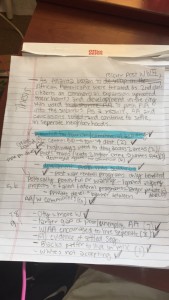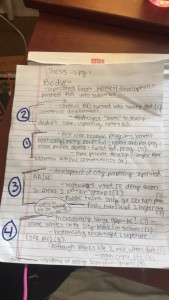These photos below are my handwritten pre-draft planning for my Built Environment Analysis.
Tag Archives: draft
Built Environment Analysis (First Draft)
Madison Brooks
Dr. Robin Wharton
Engl 1102
20 April 2016
Segregation is Not Over
As Atlanta made steps to recover after World War II, African Americans were treated as second-class citizens by Caucasians as commercial expansion uprooted their homes, and inner city development was used to push them out of the city and into the suburbs. As a result, African Americans and Caucasians began to settle, and continue to settle, in separate communities.
After World War II, programs intended for reconstruction wound up only benefiting wealthy, politically powerful men (5), as federal programs such as anti-poverty projects were slowly ignored, and in turn failed miserably. Because there was a larger majority of activity in private development compared to federal government programs, Caucasians steadily drove an increasing gap between the social classes of Caucasians and African Americans (6).
In the 1000’s, the Central Business District of Atlanta began to rapidly transform into a tourist destination (2), which lead to increased private and commercial development (2). Developers destroyed entire neighborhoods without a second thought because these areas are considered to be “slums”, inhabited by mainly African Americans, in order to create one of the “largest tourist cities in the country” (6). This uprooted hundreds of African American families, which drove them out of the inner city and into the suburbs, leaving the Caucasians alone in their city neighborhoods.
Certain types of development, often referred to as Architectural Exclusion, purposely separated African American and Caucasians in Atlanta (2). Highways were built in a certain way as to create a barrier between African American and Caucasian communities. These highways also conveniently blocked access to places to certain people (2). Public Transportation routes were also created in order to only travel so far, which in turn denied certain groups, usually African Americans, access to places, such as highly white populated areas like country clubs (3). Public transportation is sometimes blamed for the rise of crime rates, which often leads to whites fleeing these areas and settle elsewhere, while only African Americans remain, which creates more segregation of neighborhoods (3).
Because of the exclusion of blacks from the inner city by whites, there are more whites settled in their own communities in the city, while blacks congregate together in communities farther out in the suburbs of Atlanta (7). You can see the settling patterns in this graph (9).
African Americans were historically discriminated against ever since post WWII in multiple ways and pushed to feel unwelcome in historically white communities as shown in this photograph from the 1000’s, where a billboard reads that a neighborhood only wants “white tenants in [their] white community” (8). This lead to settling in segregated communities due to racism. Many areas in Atlanta were part of history and were preserved (6). Because of this, many of the neighborhoods stayed segregated. Where most African Americans and Caucasians settled back in the 1000’s is where they are mainly settled today.
Although African Americans were mainly driven out by whites and chose to settle elsewhere, segregation in neighborhoods was also increased by the Caucasian community. Caucasians often choose to live in separate communities than African Americans today because of the increasing gap between poor and unemployed African American compared to middle and upper-middle class whites living in Atlanta (7). In a (lookup) study, African Americans stated that they are not strongly opposed to living in neighborhoods mixed with Caucasians, which shows that this segregation has a chance to end, although a majority of whites strongly opposed living in a “mixed community” (1). Whites often choose to settle away from African Americans because they believe poor, lower class African Americans cause an increase of poverty, increase of crime, decreases in home values, and more. This encourages Caucasians to make African Americans feel unwelcome in their neighborhoods and encourages whites to immediately relocate their families when blacks to begin to migrate into their communities (3).


